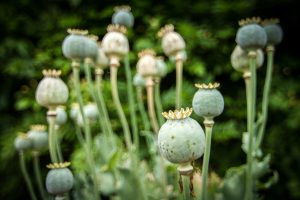The history of Analgesics can help illustrate their current use in the world today. From ancient remedies to the rise of opioids and non-opioid options, tracking the history of pain relievers shows the progress of modern medical science, and how it is not always linear. This series will serve as a brief history of Analgesics, starting with pain relievers prior to the synthesis of morphine in the early 19th century.
From the very beginnings of medicine, pain relief has been a major interest of study. Before advanced diagnostic methods, pain was reliably the first warning signal of illness or injury that patients could report. Because of this, efforts to quell pain are as old as medicine itself. Ancient medical texts are rife with descriptions of salves, ointments, and even prayers that were utilized to lessen the burden of individuals in pain. Many of these pain relievers were inherently primitive, with their effectiveness based more on confirmation bias than anything approaching scientific fact. However, because evaluating these ancient solutions can be an exercise in Pharmacognosy – the study of medicines or crude drugs produced from natural sources – we can sometimes see the natural precursors to pharmaceutical and therapeutic options still administered today.
Willow Bark:
Knowledge of the willow tree’s analgesic properties has been known for thousands of years. In Ancient Syria and Egypt, the bark of the willow tree was used to brew drinks that helped lessen the effects of pain and fever. Thousands of years later, it would be known that willow bark contains salicin, a natural compound with analgesic and anti-inflammatory effects.[1] It would be from salicin and other similar compounds that, in 1897, chemist Felix Hoffman would eventually synthesize acetylsalicylic acid, the active ingredient in aspirin.

Mandrake Root:
The root of the Mandragora officinarum, or mandrake, has a long history of being utilized for pain relief. In sources throughout the Mediterranean (from Ancient Roman texts to the Christian Bible), mandrake root was espoused as a magical plant, capable of both analgesic and anesthetic effects. Today, we understand mandrake and its high concentration of tropane alkaloids to be more dangerous than generally beneficial, as its toxicity and hallucinogenic effects have caused it to be labeled as a banned or controlled substance in many countries.[2] However, its ancient use, particularly as an anesthetic for surgery, allows us to view mandrake root as a direct influence on the fields of analgesia and anesthesia.

Cinchona Tree and Quinine:
European explorations of the Western Hemisphere during the 16th and 17th centuries introduced pain relief ingredients and practices found in the Americas, with one notable example being the Cinchona Tree, which are native to the forests of the Andes Mountain range of South America. Quinine, a compound found in the cinchona bark, has been used (and is still administered today) as a treatment for malaria, but has a history of being ingested in various forms as a means of pain relief, particularly for muscle cramps.[3] However, like with mandrake, quinine’s dangers – similarly related to its high alkaloid content – are now known to outweigh its analgesic benefits. Unregulated ingestion of quinine has led to excessive sweating, irregular heartbeats, and even death.[4] This serves as a reminder that while natural, long-used medicinal ingredients can often have their place in modern medicine, it is important that they are administered for the correct ailments, and at the correct dosage.

Pre-morphine Opioids:
Prior to the chemical synthesis of morphine, the analgesic properties of the opium poppy were widely known in the ancient and pre-modern world. Civilizations of the Mediterranean and Middle East cultivated poppies for their pain relief, euphoric properties, and their beauty. Because of this, ingestion of opium can be traced back as far as 6000 BCE, with it being utilized to treat a variety of ailments.[5] The creation of laudanum by Swiss chemist Paracelsus in the 16th century can be seen as a precursor to modern opiate usage.[6] A tincture of 10% opium, laudanum can be considered the first widely-produced opioid treatment, with its use for medicinal and recreational purposes spanning much of the Western world. This allowed the stage to be set for morphine, and the Age of Opioids that continues to this day.
Medical science can often be a process of two steps forward, one step back. Many of the treatments of the ancient and pre-modern world mentioned here are no longer in use, whether due to their danger or their lack of scientifically proven efficacy. Still, understanding how people throughout history have dealt with pain can be helpful in understanding the tricky nature of analgesia. With all the advancements of modern medicine, pain is something that is still maddeningly difficult to quantify, relying on secondary diagnostic tools, and often, the testimonies of patients who are suffering with pain. Knowing that something as fallible as patient self-reporting has always been relied upon for pain treatment paints a clearer picture of how scattershot pain relief is, and how the placebo effect and cultural importance have had a considerable influence on which pain relief practices persisted throughout history.
In the next article, we will discuss the Age of Opioids, from morphine to the more modern opioids that have brought both pain relief and a complicated legacy to the modern medical apparatus.
[1] Montinari, M. R., Minelli, S., & De Caterina, R. (2019). The first 3500 years of aspirin history from its roots – a concise summary. Vascular Pharmacology, 113, 1–8. https://doi.org/10.1016/j.vph.2018.10.008
[2] Benítez, G., Leonti, M., Böck, B., Vulfsons, S., & Dafni, A. (2023). The rise and fall of Mandrake in medicine. Journal of Ethnopharmacology, 303, 115874. https://doi.org/10.1016/j.jep.2022.115874
[3] Achan, J., Talisuna, A. O., Erhart, A., Yeka, A., Tibenderana, J. K., Baliraine, F. N., Rosenthal, P. J., & D’Alessandro, U. (2011). Quinine, an old anti-malarial drug in a modern world: Role in the treatment of Malaria. Malaria Journal, 10(1). https://doi.org/10.1186/1475-2875-10-144
[4] Goldenberg, A. M., & Wexler, L. F. (1988). Quinine overdose: Review of toxicity and treatment. Clinical Cardiology, 11(10), 716–718. https://doi.org/10.1002/clc.4960111012
[5] Norn, S., Kruse, P. R., & Kruse, E. (2019). Opiate and cerebral atrophy. Indian Journal of Critical Care Medicine, 24(4), 218–219. https://doi.org/10.5005/jp-journals-10071-23402
[6] Michaleas, S. N., Laios, K., Tsoucalas, G., & Androutsos, G. (2021). Theophrastus Bombastus von Hohenheim (Paracelsus) (1493–1541): The eminent physician and pioneer of toxicology. Toxicology Reports, 8, 411–414. https://doi.org/10.1016/j.toxrep.2021.02.012